
Recognizing the value of interdisciplinary collaboration and systems thinking, RAND Corporation researchers, supported by RAND Corporation investment funds, have developed a systems-level, blue-sky approach to conceptualizing and visualizing a 21st-century U.S. workforce development and employment system. A new report from RAND is the first step in moving the United States to a system that accounts for workers’ needs for lifelong learning, employers’ continuously changing workforce requirements, rapid and often disruptive changes in technology, and the ever-evolving nature of work. This publication should be of interest to educators, business leaders, policymakers, researchers, and other stakeholders who are engaged in issues relating to workforce education and training and the future of work.
Key Findings
- The current approach to workforce preparation in the United States — a linear pipeline from K–12 education to possibly college and then a job — is similar to what it was several decades ago, despite technological change, globalization, and important demographic changes.
- The current pipeline may be sufficient for some, but there are clear shortfalls that need to be addressed. For instance, segments of the workforce do not have access to clear and meaningful paths to retraining throughout their working lives when their skills become obsolete, and many employers struggle to find workers who possess the desired 21st-century skills.
- The United States needs an integrated, data-driven 21st-century workforce development and employment system to ensure that people have equitable access to opportunities for acquiring in-demand skills over the course of their working lives and to ensure timely and appropriate matching and rematching of skilled workers with jobs to which they are well suited over their time in the labor market.
- The transformation to a 21st-century system should be guided by (1) relevant data and metrics to track system processes and monitor outcomes; (2) tools to support the design of innovative solutions to system shortcomings, followed by rigorous testing to determine what works and what does not; and (3) mechanisms to disseminate, scale up, and further refine proven approaches. Such efforts will be necessary to achieve the data-driven, integrated, equitable, and responsive system needed today.
For the full report, see https://www.rand.org/pubs/research_reports/RR2768.html
For a brief, see https://www.rand.org/pubs/research_briefs/RB10074.html
